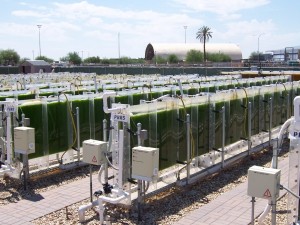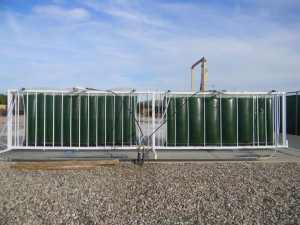August 2, 2012
 AzCATI continues to be a crucial forefront of innovation in biofuels, bio-product research, and commercialization of algae-based goods. The research hub has taken significant strides in their mission to serve as a national test bed to accelerate the advancement of algae technology for the future. Although there are many goals that have been accomplished, a primary focus today at AzCATI is to continue research in producing a low-cost and efficient feedstock for biofuel production. Peter Zemke, technical lead of photobioreactors at AzCATI, chatted with me last week on some progress taking place to pursue this goal.
AzCATI continues to be a crucial forefront of innovation in biofuels, bio-product research, and commercialization of algae-based goods. The research hub has taken significant strides in their mission to serve as a national test bed to accelerate the advancement of algae technology for the future. Although there are many goals that have been accomplished, a primary focus today at AzCATI is to continue research in producing a low-cost and efficient feedstock for biofuel production. Peter Zemke, technical lead of photobioreactors at AzCATI, chatted with me last week on some progress taking place to pursue this goal.
Algae, like any plant, needs light and energy to grow. A photobioreactor (PBR) incorporates both sources of light and energy input into a reactor to provide the feedstock necessary for algae to develop. For example, an open pond is a photobioreactor because natural sunlight and energy produce algae growth; but mostly, the term photobioreactor refers to a closed system in which no direct exchange of gasses or contaminants in the environment mix with algae in their growth process. The closed photobioreactors enable AzCATI technicians to better control the algae’s biocultural conditions; such as light intensity, pH, carbon dioxide, and temperature levels.
There are many different types of photobioreactors. Many are in use or being tested at AzCATI. Zemke's team is currently focusing on two variations of a flat-plate photobioreactor specifically for mass production of algae.
Flat-plate photobioreactors are used because of their large illumination surface area, providing a great light path, which is suitable for outdoor cultures. Another benefit is that they produce a good amount of algal biomass. Biomass is the biological material from algae that can be used or converted into energy products such as biofuel. Although they are a relatively cheaper option than other PBR’s, such as the tubular photobioreactor, flat-plate PBR’s are still very expensive nonetheless, which leads researchers to continue searching for options that offer greater possibilities in biofuel production.
 The plastic film photobioreactors are a relatively new technology that is being tested at AzCATI. The results so far have proven positive, especially in the cost that it takes to maintain them. Plastic film photobioreactors are also able to produce more biomass than acrylic, and the structure, which is made up of steel bars, is more durable and will last longer than the transparent acrylic structure made up in the acrylic photobioreactors. Another benefit of thin film PBR’s is that plastic is cheap and if punctured, is easier to replace. “We are very much focused on the plastic film photobioreactors over all,” Zemke said. “The effort is so much less than the acrylic photobioreactors.”
The plastic film photobioreactors are a relatively new technology that is being tested at AzCATI. The results so far have proven positive, especially in the cost that it takes to maintain them. Plastic film photobioreactors are also able to produce more biomass than acrylic, and the structure, which is made up of steel bars, is more durable and will last longer than the transparent acrylic structure made up in the acrylic photobioreactors. Another benefit of thin film PBR’s is that plastic is cheap and if punctured, is easier to replace. “We are very much focused on the plastic film photobioreactors over all,” Zemke said. “The effort is so much less than the acrylic photobioreactors.”
For the time being, it seems as if plastic film photobioreactors are the best option, however that does not mean the research stops there. It is important for AzCATI to continue research and development in finding the best strains of algae- the ones that are the best at doing various things such as biofuels, feed, pigments, or nutracuticals, thriving in harsh conditions, or cleaning up wastewater. The development of the best technology to cultivate those strains is vital. Zemke used the upcoming summer Olympics as an example of how the roles of algae strain and photobioreactor development go hand-in-hand.
“The role of research and development into algae strains is essentially to find the Olympians of the algae world,” Zemke said. “Just as athletes need the right equipment to excel at their respective sports, algae need the right photobioreactor to perform at their peak.”
Out of only a small handful of labs in the world, AzCATI is one of the biggest to conduct photobioreactor research. As a result of their photobioreactor technology, AzCATI has the capability to produce larger and more reliable quantities of algae biomass of better quality than any other research institution in the U.S.
“Here at AzCATI, we find the Olympian algae strains, figure out what light, temperature, and mixing conditions they need to perform their best, then design or select a photobioreactor that creates these conditions for them,” Zemke said.
The path of learning how to develop better photobioreactors, in terms of performance, reliability, and cost, is still a road of research ahead. Let’s salute AzCATI for keeping up the hard work in their efforts to reach for the algae gold medal!
Written by Gabrielle Olson, ASU LightWorks

